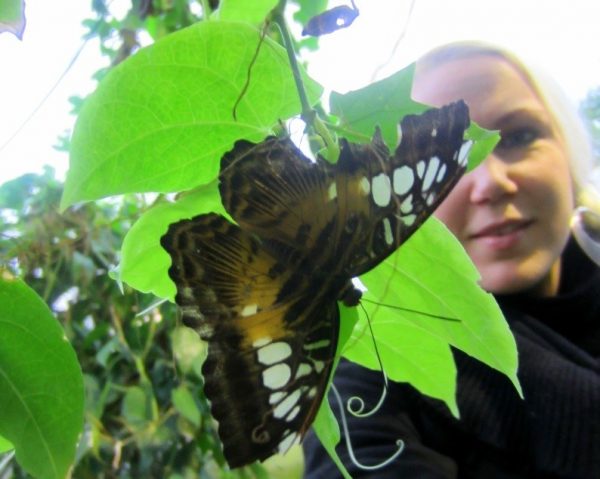Jolyon Troscianko, Exeter University
 Abstract: Evading detection is crucial for the survival of many animals, and number of different means of achieving camouflage have been discovered. I will discuss my recent work investigating whether some types of camouflage are more easily learnt than others. If predators learn to find one type of prey more efficiently than others over successive encounters, this could create frequency dependent selection, and help to explain the diversity of camouflage strategies we see in nature. In addition, I will discuss some recent work on objectively modelling the conspicuousness of camouflaged prey. Such models are frequently used to measure levels of camouflage or visual difference, but their efficacy has rarely been tested and compared to alternatives. I found that a novel method for quantifying edge disruption was the best predictor of capture times; this technique could in turn help us to finally form a definition of disruptive camouflage, demonstrating the need for combining neurophysiology with behaviour and modelling approaches to understand how camouflage works.
Abstract: Evading detection is crucial for the survival of many animals, and number of different means of achieving camouflage have been discovered. I will discuss my recent work investigating whether some types of camouflage are more easily learnt than others. If predators learn to find one type of prey more efficiently than others over successive encounters, this could create frequency dependent selection, and help to explain the diversity of camouflage strategies we see in nature. In addition, I will discuss some recent work on objectively modelling the conspicuousness of camouflaged prey. Such models are frequently used to measure levels of camouflage or visual difference, but their efficacy has rarely been tested and compared to alternatives. I found that a novel method for quantifying edge disruption was the best predictor of capture times; this technique could in turn help us to finally form a definition of disruptive camouflage, demonstrating the need for combining neurophysiology with behaviour and modelling approaches to understand how camouflage works.
Biography: I have a background in behavioural ecology and sensory ecology, asking questions such as how an animal’s cognition or appearance to other animals affects how they interact with their environment, and how this in turn affects their evolution (see my publications).I’m currently a postdoctoral research associate, working on a BBSRC grant to Martin Stevens and John Skelhorn, investigating how easily predators can learn and switch between different camouflage strategies. I’m testing this using a series of touch-screen experiments on humans and laboratory chickens, training them to find computer generated “moths” that are concealed with different types of camouflage. For more information visit: http://www.jolyon.co.uk/myresearch/
Karin Kjernsmo, CamoLab, School of Biological Sciences – University of Bristol
 Abstract: The ongoing evolutionary arms race between predators that try to outsmart their prey, and prey which in turn tries to avoid getting eaten has resulted in an impressive variety of morphological and behavioural adaptations. The numerous ways animals can use their colour patterns to avoid getting eaten provided Wallace and Darwin with important examples for illustrating and defending their ideas of natural selection and adaptation. Eyespots are a prominent example of such colour patterns. Consisting of roughly concentric rings of contrasting colours, they have received their name because to humans they often resemble the vertebrate eye. Eyespots are common in many terrestrial taxa such as insects (particularly in the order Lepidoptera), birds and reptiles, and they are also widespread in many aquatic taxa such as molluscs, flatworms and fishes. Because of their salience and taxonomically wide occurrence, eyespots have intrigued naturalists and biologists for more than a century, but disentangling their adaptive and functional significance has proven to be quite a challenge.In this talk, I will present the results of our recent studies investigating the anti-predator utility of eyespots. The adaptive value and function of eyespots have received much attention and have been studied particularly in terrestrial systems, but far less is known about them in aquatic systems. This is despite the fact that all types of protective coloration found in terrestrial environments also exist in the aquatic environment and have probably initially evolved there. In order to study the functions and adaptive value of eyespots in aquatic environments, I have developed an “aquatic novel world”, where I use naïve, visually hunting fish as predators, and artificial prey. As you will see, eyespots provide numerous ways for prey to manipulate predator behaviour and that way decrease predation risk.
Abstract: The ongoing evolutionary arms race between predators that try to outsmart their prey, and prey which in turn tries to avoid getting eaten has resulted in an impressive variety of morphological and behavioural adaptations. The numerous ways animals can use their colour patterns to avoid getting eaten provided Wallace and Darwin with important examples for illustrating and defending their ideas of natural selection and adaptation. Eyespots are a prominent example of such colour patterns. Consisting of roughly concentric rings of contrasting colours, they have received their name because to humans they often resemble the vertebrate eye. Eyespots are common in many terrestrial taxa such as insects (particularly in the order Lepidoptera), birds and reptiles, and they are also widespread in many aquatic taxa such as molluscs, flatworms and fishes. Because of their salience and taxonomically wide occurrence, eyespots have intrigued naturalists and biologists for more than a century, but disentangling their adaptive and functional significance has proven to be quite a challenge.In this talk, I will present the results of our recent studies investigating the anti-predator utility of eyespots. The adaptive value and function of eyespots have received much attention and have been studied particularly in terrestrial systems, but far less is known about them in aquatic systems. This is despite the fact that all types of protective coloration found in terrestrial environments also exist in the aquatic environment and have probably initially evolved there. In order to study the functions and adaptive value of eyespots in aquatic environments, I have developed an “aquatic novel world”, where I use naïve, visually hunting fish as predators, and artificial prey. As you will see, eyespots provide numerous ways for prey to manipulate predator behaviour and that way decrease predation risk.
Biography: My education began in Sweden, where I obtained a BSc and MSc degree in Zoology at the University of Gothenburg. I then moved to Turku, Finland, where I completed my PhD project entitled “Anti-predator Adaptations in Aquatic Environments” (supervised by Dr. Sami Merilaita, åbo Akademi Univ. and Prof. Jörgen I. Johnson, Univ. of Gothenburg) at Åbo Akademi University. In late July 2015, I moved from Turku to Bristol and started working in the Camo Lab as a Research Associate, on a 3-year BBSRC funded project investigating whether iridescence can be deceptive (lead by Prof. Innes Cuthill, Dr. Nick Scott-Samuel & Dr. Heather Whitney).
Prof. Daniel Osorio, School of Life Sciences, University of Sussex
 Abstract: Cuttlefish are a type of mollusc, which has evolved excellent vision independently of vertebrates, and can change their appearance to conceal themselves from predatory fish. The flexibility and subtlety of this adaptive camouflage gives remarkable insight into the vision in a non-human species, and I will talk today about how they respond to patterns of light and shadow to select their coloration pattern.
Abstract: Cuttlefish are a type of mollusc, which has evolved excellent vision independently of vertebrates, and can change their appearance to conceal themselves from predatory fish. The flexibility and subtlety of this adaptive camouflage gives remarkable insight into the vision in a non-human species, and I will talk today about how they respond to patterns of light and shadow to select their coloration pattern.
Biography: Daniel Osorio is at the University of Sussex, where he has studied colour vision and camouflage is a wide range of animals, but never humans.
 Abstract: Evading detection is crucial for the survival of many animals, and number of different means of achieving camouflage have been discovered. I will discuss my recent work investigating whether some types of camouflage are more easily learnt than others. If predators learn to find one type of prey more efficiently than others over successive encounters, this could create frequency dependent selection, and help to explain the diversity of camouflage strategies we see in nature. In addition, I will discuss some recent work on objectively modelling the conspicuousness of camouflaged prey. Such models are frequently used to measure levels of camouflage or visual difference, but their efficacy has rarely been tested and compared to alternatives. I found that a novel method for quantifying edge disruption was the best predictor of capture times; this technique could in turn help us to finally form a definition of disruptive camouflage, demonstrating the need for combining neurophysiology with behaviour and modelling approaches to understand how camouflage works.
Abstract: Evading detection is crucial for the survival of many animals, and number of different means of achieving camouflage have been discovered. I will discuss my recent work investigating whether some types of camouflage are more easily learnt than others. If predators learn to find one type of prey more efficiently than others over successive encounters, this could create frequency dependent selection, and help to explain the diversity of camouflage strategies we see in nature. In addition, I will discuss some recent work on objectively modelling the conspicuousness of camouflaged prey. Such models are frequently used to measure levels of camouflage or visual difference, but their efficacy has rarely been tested and compared to alternatives. I found that a novel method for quantifying edge disruption was the best predictor of capture times; this technique could in turn help us to finally form a definition of disruptive camouflage, demonstrating the need for combining neurophysiology with behaviour and modelling approaches to understand how camouflage works.
 Abstract: The ongoing evolutionary arms race between predators that try to outsmart their prey, and prey which in turn tries to avoid getting eaten has resulted in an impressive variety of morphological and behavioural adaptations. The numerous ways animals can use their colour patterns to avoid getting eaten provided Wallace and Darwin with important examples for illustrating and defending their ideas of natural selection and adaptation. Eyespots are a prominent example of such colour patterns. Consisting of roughly concentric rings of contrasting colours, they have received their name because to humans they often resemble the vertebrate eye. Eyespots are common in many terrestrial taxa such as insects (particularly in the order Lepidoptera), birds and reptiles, and they are also widespread in many aquatic taxa such as molluscs, flatworms and fishes. Because of their salience and taxonomically wide occurrence, eyespots have intrigued naturalists and biologists for more than a century, but disentangling their adaptive and functional significance has proven to be quite a challenge.In this talk, I will present the results of our recent studies investigating the anti-predator utility of eyespots. The adaptive value and function of eyespots have received much attention and have been studied particularly in terrestrial systems, but far less is known about them in aquatic systems. This is despite the fact that all types of protective coloration found in terrestrial environments also exist in the aquatic environment and have probably initially evolved there. In order to study the functions and adaptive value of eyespots in aquatic environments, I have developed an “aquatic novel world”, where I use naïve, visually hunting fish as predators, and artificial prey. As you will see, eyespots provide numerous ways for prey to manipulate predator behaviour and that way decrease predation risk.
Abstract: The ongoing evolutionary arms race between predators that try to outsmart their prey, and prey which in turn tries to avoid getting eaten has resulted in an impressive variety of morphological and behavioural adaptations. The numerous ways animals can use their colour patterns to avoid getting eaten provided Wallace and Darwin with important examples for illustrating and defending their ideas of natural selection and adaptation. Eyespots are a prominent example of such colour patterns. Consisting of roughly concentric rings of contrasting colours, they have received their name because to humans they often resemble the vertebrate eye. Eyespots are common in many terrestrial taxa such as insects (particularly in the order Lepidoptera), birds and reptiles, and they are also widespread in many aquatic taxa such as molluscs, flatworms and fishes. Because of their salience and taxonomically wide occurrence, eyespots have intrigued naturalists and biologists for more than a century, but disentangling their adaptive and functional significance has proven to be quite a challenge.In this talk, I will present the results of our recent studies investigating the anti-predator utility of eyespots. The adaptive value and function of eyespots have received much attention and have been studied particularly in terrestrial systems, but far less is known about them in aquatic systems. This is despite the fact that all types of protective coloration found in terrestrial environments also exist in the aquatic environment and have probably initially evolved there. In order to study the functions and adaptive value of eyespots in aquatic environments, I have developed an “aquatic novel world”, where I use naïve, visually hunting fish as predators, and artificial prey. As you will see, eyespots provide numerous ways for prey to manipulate predator behaviour and that way decrease predation risk. Abstract: Cuttlefish are a type of mollusc, which has evolved excellent vision independently of vertebrates, and can change their appearance to conceal themselves from predatory fish. The flexibility and subtlety of this adaptive camouflage gives remarkable insight into the vision in a non-human species, and I will talk today about how they respond to patterns of light and shadow to select their coloration pattern.
Abstract: Cuttlefish are a type of mollusc, which has evolved excellent vision independently of vertebrates, and can change their appearance to conceal themselves from predatory fish. The flexibility and subtlety of this adaptive camouflage gives remarkable insight into the vision in a non-human species, and I will talk today about how they respond to patterns of light and shadow to select their coloration pattern.